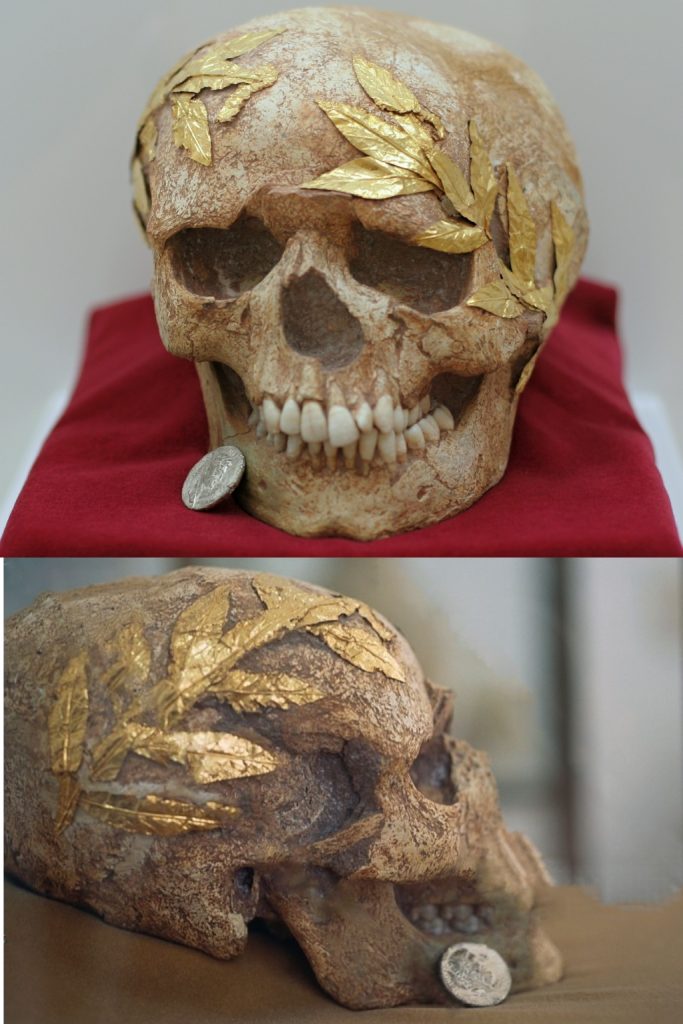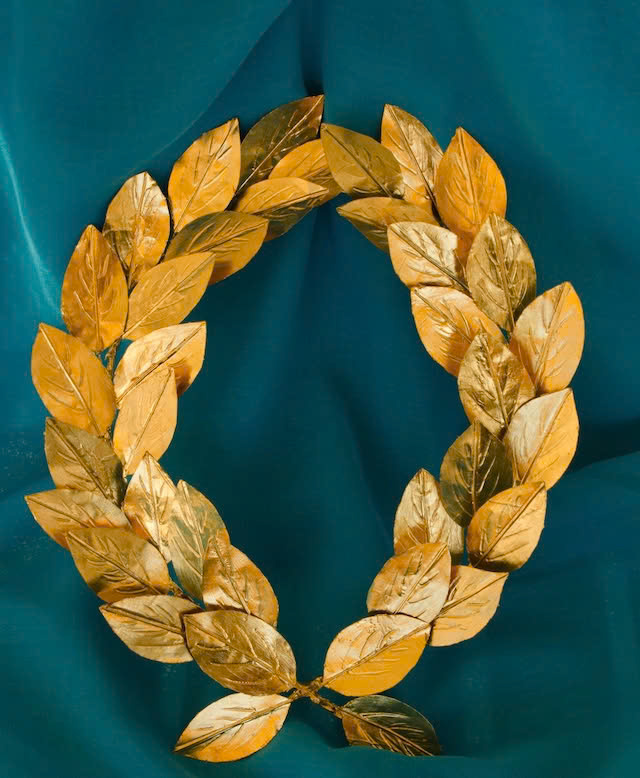In an extraordinary discovery that spans the chasm of time, archaeologists have uncovered a rare and breathtaking artifact in the ancient city of Lato on the island of Crete. A human skull, still adorned with its golden wreath after 2,500 years, has come to light, offering a profound glimpse into the artistry, cultural values, and burial practices of ancient Greek society. This find not only highlights the wealth and craftsmanship of a bygone era but also provides a compelling narrative about their beliefs surrounding death and the afterlife.
A Fascinating Discovery
Deep within the cemetery of Lato, researchers unearthed a stunning sight: a skull crowned with an intricately designed golden wreath fashioned to resemble laurel branches. Alongside this magnificent relic lay a silver coin placed within the mouth of the deceased—a traditional offering meant for Charon, the mythical ferryman of Hades. This practice reflects the belief that the soul required payment to cross the River Styx into the afterlife, emphasizing the profound spiritual and ritualistic significance attached to burial customs in ancient Greece.

Lato: An Ancient Stronghold
The site of this discovery, Lato, was a prominent city-state in eastern Crete. Founded long before the arrival of the Dorians, the city flourished during the 5th and 4th centuries BCE. Strategically positioned between two peaks overlooking Mirabello Bay, Lato served as both a military stronghold and a center of religious life. Its elevated location provided natural defense, while its proximity to the sea facilitated trade and communication with other city-states.
The city’s name is thought to derive from Leto, the goddess who was the mother of Apollo and Artemis. This association underlines Lato’s religious significance, which extended beyond its architectural achievements to include its cultural identity. Evidence of this importance is found in the coins minted by the city, some of which depict the goddess Eileithyia, revered as the divine midwife and protector of childbirth.
Symbols of Prestige and Belief
The Golden Wreath
The golden wreath discovered with the skull is far more than a decorative object. In ancient Greek society, wreaths made from laurel, olive, or myrtle branches symbolized honor and achievement. They were bestowed upon victors in athletic competitions, celebrated military leaders, and other distinguished individuals. The laurel wreath, in particular, was closely associated with Apollo, the god of music, prophecy, and the arts. Its presence in this burial suggests that the individual may have been an accomplished athlete or someone of significant stature within their community.

Crafted with exquisite detail, the wreath exemplifies the technical mastery of ancient Greek goldsmiths. Its durability over millennia is a testament to both the quality of its craftsmanship and the respect with which it was placed as part of the deceased’s final journey.
The Ferryman’s Fee
The silver coin found within the skull’s mouth sheds light on another deeply rooted Greek tradition. According to ancient mythology, the soul of the deceased needed to pay Charon, the ferryman, to gain passage across the River Styx and enter the realm of the dead. Without this fee, the soul was believed to wander aimlessly, unable to reach its destination. This practice underscores the Greeks’ intricate beliefs about death and their meticulous attention to ensuring a proper transition to the afterlife.
Such burial customs also provide insight into the societal structure and personal relationships of the time. The care invested in preparing the deceased for their journey reflects not only the spiritual priorities of the community but also the profound love and respect for the individual being laid to rest.
The Legacy of Lato
While the golden-crowned skull is among the most remarkable finds, it is far from the only treasure unearthed at Lato. Numerous artifacts from this ancient city have been preserved, offering a wealth of knowledge about the people who lived there. The Archaeological Museum of Agios Nikolaos, which has long housed significant relics from eastern Crete, became the custodian of this discovery, displaying it alongside other objects that showcase the region’s rich cultural heritage.
Although the museum is temporarily closed, the golden wreath and its accompanying skull remain iconic symbols of the sophistication of ancient Greek civilization. These artifacts serve as a bridge between the modern world and an era that continues to inspire awe and curiosity.
Preserving the Past for the Future
This incredible find resonates not only with archaeologists but also with history enthusiasts and the general public, reminding us of the timeless connection between humanity and its past. Such discoveries offer a tangible link to ancient customs, beliefs, and artistry, helping to paint a fuller picture of civilizations long gone.

Efforts to preserve and study these artifacts are crucial to understanding the cultural legacy of ancient Greece. By examining the materials, techniques, and contexts of these objects, researchers can gain invaluable insights into the daily lives, spiritual beliefs, and societal values of the people who created them. Furthermore, these treasures highlight the importance of safeguarding historical sites and artifacts for future generations.
A Story Written in Gold
The golden-crowned skull of Lato stands as a remarkable testament to the artistry, spirituality, and respect for life and death that characterized ancient Greek culture. Its discovery offers more than a glimpse into the past; it serves as a reminder of the universality of human experience and the enduring quest to honor those who came before us. For modern audiences, this find is not just an archaeological marvel but also a source of inspiration, sparking reflection on the beauty and fragility of life.
As we continue to uncover stories like that of the laurel-wreathed skull, we are reminded of the profound legacy left by ancient civilizations. These artifacts, though silent, speak volumes about the human journey—an enduring narrative etched in gold, silver, and stone.





